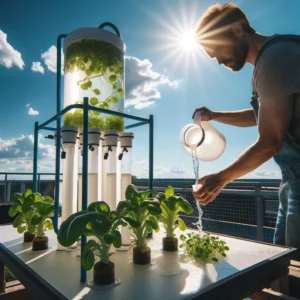
The Ultimate Guide to Feeding Your Hydroponic Plants
In the world of hydroponics, you become your plants’ sole source of sustenance. Unlike soil, where nutrients are slowly released over time, hydroponic systems require you to provide a carefully balanced diet directly in their water supply. Understanding how often to feed your plants is critical for their health and productivity.
It’s important to note that there’s no one-size-fits-all answer when it comes to feeding frequency. The perfect schedule depends on factors like your plant species, the stage of growth, and even the type of hydroponic system you’re using.
Don’t worry, this guide will break down the key concepts and help you find the feeding rhythm that keeps your hydroponic garden flourishing!
Factors Influencing Feeding Frequency
Let’s dive into the elements that play a significant role in deciding how often to replenish those nutrients:
- Plant Type: Think of it like different dietary needs for humans. Fast-growing, leafy greens like lettuce are ravenous, needing frequent feeding. Slower-growing fruiting plants, such as tomatoes or peppers, can often get by with slightly less frequent feedings.
- Growth Stage: Young seedlings and plants just starting out usually need a more diluted nutrient solution and might not require feeding as often. However, once your plants hit their vigorous growth phase, especially when flowering and fruiting, they’ll need a more regular supply of nutrients to support their increased production.
- System Type: The way your hydroponic system is designed matters!
- Circulating Systems (like DWC or NFT): The constant water movement helps keep nutrients available. You might be able to get away with feeding slightly less often.
- Static Systems (like Kratky): Nutrients can become depleted more quickly, potentially requiring more frequent topping up or solution changes.
- Environmental Conditions:
- Temperature: Warm temperatures speed up plant metabolism, meaning they use nutrients faster. You might need to feed more often in hot weather.
- Light: More light equals more photosynthesis and growth. Plants basking in ample light will generally need more frequent feeding to sustain their activity.
How Often? General Guidelines
While every hydroponic garden is unique, here’s a starting point to help you get your bearings:
- Starting Point: Always begin by consulting the directions on your chosen hydroponic fertilizer. Most products provide recommended feeding schedules or concentration levels.
- Observation is Key: The most important tool in your hydroponic toolkit is your eyes! Regularly observe your plants for signs they might need more or less food:
- Overfertilization: Leaf tips might appear brown or burnt, growth may be stunted, or you might see a buildup of salts on the growing medium.
- Underfeeding: Yellowing leaves (especially older ones), slow growth, or a generally weak appearance can indicate a lack of nutrients.
- Typical Ranges: Keeping in mind plants have individual needs, here’s a broad range:
- Leafy Greens: In circulating setups, feeding every 1-2 days is common, while static systems might need it daily.
- Fruiting Plants: Feeding every 2-3 days might be enough, especially in the early fruiting stages. Needs usually ramp up a bit as fruits get larger.
- pH and EC Monitoring: Don’t neglect these! Even if you feed on schedule, issues with pH or overall nutrient concentration (EC) can prevent your plants from being able to properly absorb what you’re providing.
Important: These are starting points. Finding the optimal feeding frequency is an ongoing, observant process!
Just to throw this out there, Lettuce Grow has made this process as easy as pickin your nose. Check out the Farmstand and let your hydroponic tower water itself!
The Farmstand Is Your Self-Watering, Self-Fertilizing Solution for an Easy to Grow Harvest
When to Change Your Nutrient Solution
While topping up your reservoir as needed is part of hydroponic maintenance, sometimes a complete swap for fresh nutrients is necessary. Here’s how to know when it’s time:
- Small Systems: If you have a smaller hydroponic setup (think a few gallons), a complete nutrient solution change every week or two is generally recommended.
- Large Systems: With larger reservoirs, you might get away with simply topping up the nutrient levels (as indicated by your EC readings) and doing a full change less frequently, perhaps every few weeks.
- Signs It’s Time: Don’t rely solely on a calendar, look for these telltale signs:
- Low EC: If your EC readings remain low across the board, even after topping up, it means the nutrient solution overall is too depleted.
- Algae Growth: Algae blooms indicate an imbalance in your system, and a fresh start is often the easiest fix.
- Unhealthy Plants: If your plants generally look unhappy and you’ve ruled out other problems (pests, incorrect pH), a fresh nutrient solution can give them a clean slate.
Important Tip: When doing a complete solution change, always rinse your reservoir thoroughly to remove any buildup or residue before adding your fresh nutrient mix.
Conclusion
Finding the perfect feeding rhythm for your hydroponic plants is a key part of achieving a lush and productive garden. Remember, while general guidelines are helpful, the most important factor is paying close attention to how your plants respond. Think of their appearance and growth rate as their way of communicating their needs.
By understanding the factors that influence feeding frequency, regularly monitoring your nutrient solution (EC and pH), and observing your plants, you’ll become an expert in providing optimal nutrition. Don’t be afraid to experiment a little at the beginning – the journey of learning and refining your technique is part of the joy of hydroponics!
FAQ: Feeding Your Hydroponic Plants
- My plants seem to be overfed, what should I do? If you notice signs like burnt leaf tips, stunted growth, or salt residue, the first step is to flush your system with plain, pH-balanced water to dilute the excess nutrients. After that, resume feeding with a weaker nutrient solution.
- Can I use regular garden fertilizer in my hydroponic system? No! Regular fertilizers often contain ingredients that aren’t water-soluble, have an incorrect pH for hydroponics, or lack the right balance of nutrients. Always use fertilizers specifically designed for hydroponic use.
- How often should I check the pH and EC of my solution? Ideally, check pH and EC at least twice a week. For fast-growing plants or smaller systems, more frequent monitoring might be necessary to catch any fluctuations quickly.
- My EC keeps dropping, but my plants don’t look like they’re getting enough nutrients. What’s wrong? This could indicate a pH issue. If your pH is out of the optimal range, your plants won’t be able to absorb nutrients effectively, even if they are present. Check and adjust your pH as needed.
- What’s the ideal EC range for my plants? Unfortunately, there’s no single answer. The optimal EC depends on the specific type of plant and its growth stage. Research the recommended ranges for your chosen crops.



